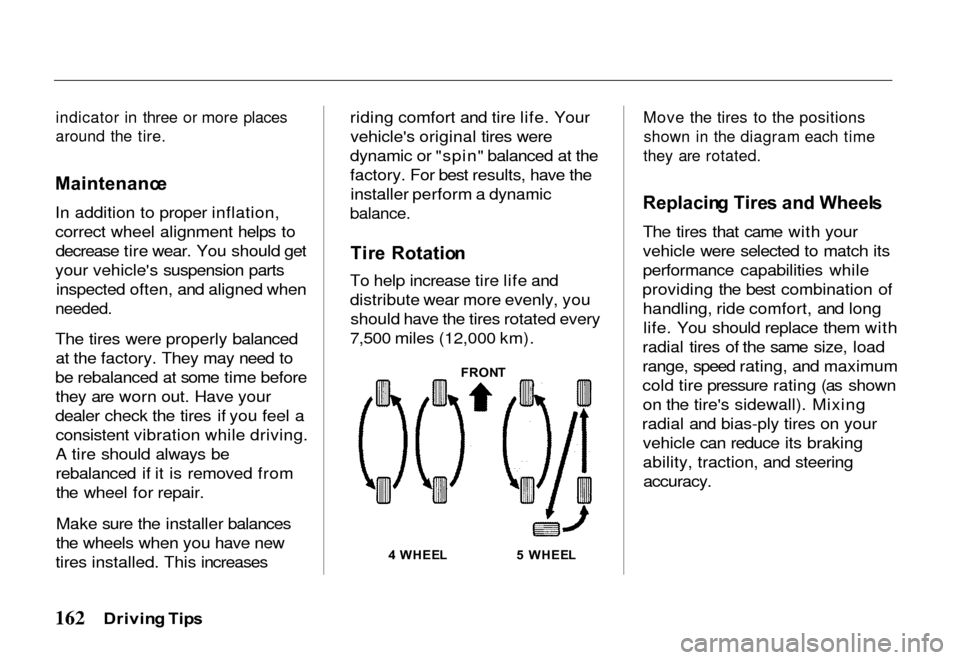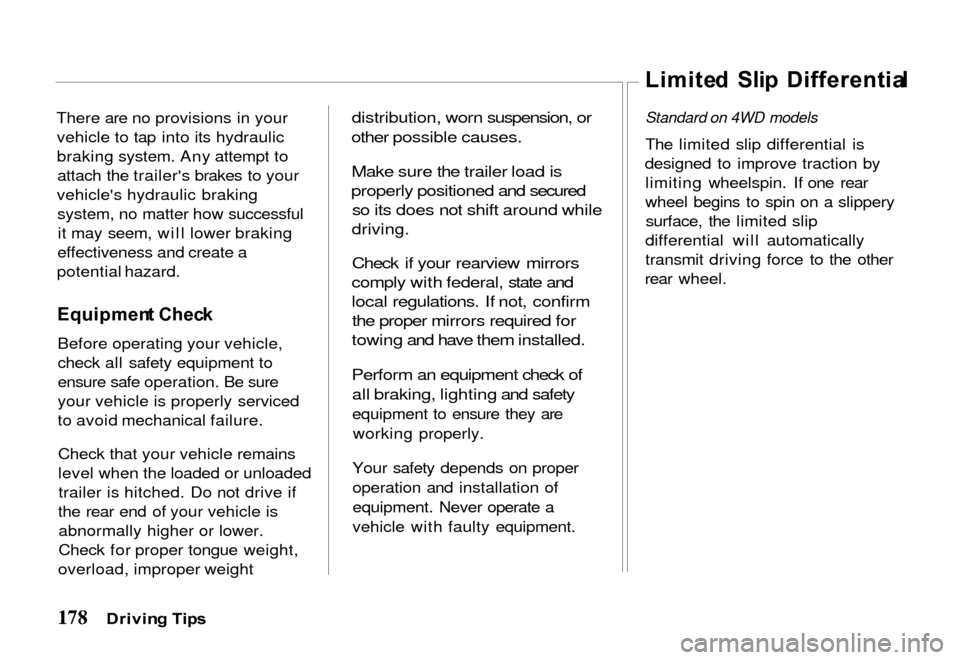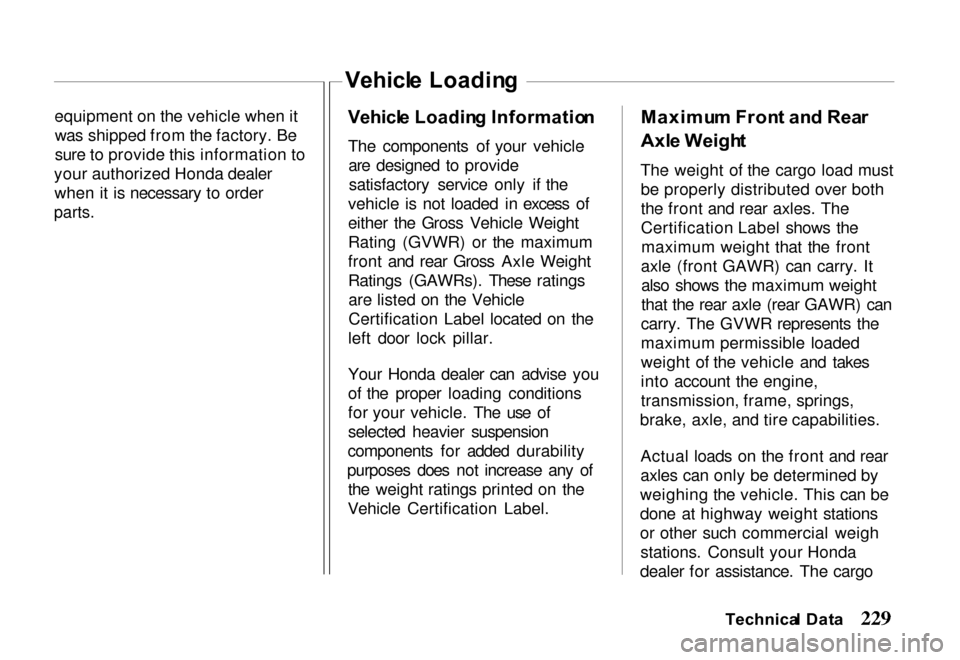Page 165 of 267

indicator in three or more places
around the tire.
Maintenanc e
In addition to proper inflation,
correct wheel alignment helps to decrease tire wear. You should get
your vehicle's suspension parts inspected often, and aligned when
needed.
The tires were properly balanced at the factory. They may need to
be rebalanced at some time before they are worn out. Have your
dealer check the tires if you feel a consistent vibration while driving.
A tire should always be
rebalanced if it is removed fromthe wheel for repair.
Make sure the installer balances
the wheels when you have new
tires installed. This increases riding comfort and tire life. Your
vehicle's original tires were
dynamic or "spin" balanced at the
factory. For best results, have the installer perform a dynamic
balance.
Tir e Rotatio n
To help increase tire life and
distribute wear more evenly, you should have the tires rotated every
7,500 miles (12,000 km).
Move the tires to the positions
shown in the diagram each time
they are rotated.
Replacin g Tire s an d Wheel s
The tires that came with your
vehicle were selected to match its
performance capabilities while
providing the best combination of handling, ride comfort, and longlife. You should replace them with
radial tires of the same size, load
range, speed rating, and maximum
cold tire pressure rating (as shown on the tire's sidewall). Mixing
radial and bias-ply tires on your vehicle can reduce its braking
ability, traction, and steering
accuracy.
Drivin g Tip s
FRON
T
4 WHEE L
5 WHEE L
Page 181 of 267

There are no provisions in your
vehicle to tap into its hydraulic
braking system. Any attempt toattach the trailer's brakes to your
vehicle's hydraulic braking system, no matter how successfulit may seem, will lower braking
effectiveness and create a
potential hazard.
Equipmen t Chec k
Before operating your vehicle,
check all safety equipment to
ensure safe operation. Be sure
your vehicle is properly serviced
to avoid mechanical failure.
Check that your vehicle remains
level when the loaded or unloadedtrailer is hitched. Do not drive if
the rear end of your vehicle is abnormally higher or lower.
Check for proper tongue weight,
overload, improper weight
distribution, worn suspension, or
other possible causes.
Make sure the trailer load is
properly positione
d and secured
so its does not shift around whil
e
driving.
Chec k
if your rearview mirrors
comply with federal, state and
local regulations. If not, confirm
the proper mirrors required for
towing and have them installed.
Perform an equipment check of
all braking, lighting and safety
equipment to ensure they are working properly.
Your safety depends on proper
operation and installation of
equipment. Never operate a
vehicle with faulty equipment.
Limite
d Sli p Differentia l
Standard on 4WD models
The limited slip differential is
designed to improve traction by limiting wheelspin. If one rear
wheel begins to spin on a slipperysurface, the limited slip
differential will automatically
transmit driving force to the other
rear wheel.
Drivin g Tip s
Page 223 of 267

Accelerato
r Peda l Linkag e
Lubricate the accelerator pedal
fulcrum pin with multipurpose
Whee l Alignmen t
Proper wheel alignment improves tire mileage. Your vehicle's
suspension parts should be
inspected often and aligned when
needed (see the "Technical Data" section). Improper alignment will
cause the front tires to roll at an angle that will result in faster tire
wear.
Proper tire balancing provides the
best riding comfort and helps
reduce tire tread wear. Out-of-balance tires can cause
annoying vibration and uneven
tire wear such as cupping and flat
spots.
Exterio
r
Washin g You r Vehicl e
The best way to preserve your vehicle's finish is to keep it clean by
frequent washings. Wash the vehicle
with lukewarm or cold water.
Do not use hot water or wash in direct sunlight. Do not use strong
soap or chemical detergents. All
cleaning agents should be promptly
flushed from the surface and not
allowed to dry on the finish.
Polishin g an d Waxin g
You r Vehicl e
Polishing is recommended to
remove accumulated residue and eliminate any "weathered"
appearance.
Your Honda dealer offers several
polishes and cleaners that have
proven to maintain the original finish appearance and durability. Protectio
n o f Exterio r
Brigh t Meta l Part s
Bright metal parts should be cleaned
regularly to keep their luster.
Washing with water is all that is
usually needed. However, chrome
polish may be used on chrome or stainless steel trim, if necessary. A
coating of wax, rubbed to a high
polish, is recommended for all bright metal parts.
Car e o f Aluminu m Wheel s
Aluminum wheels have a clear-coat finish similar to paint.
Use a chamois skin, sponge or
other soft material when washing
the wheels.
Foreig n Materia l Deposit s
Calcium chloride and other salts, ice melting agents, road oil and
tar, tree sap, bird droppings,
Car e an d Maintenanc e
Page 232 of 267

equipment on the vehicle when it
was shipped from the factory. Be
sure to provide this information to
your authorized Honda dealer when it is necessary to order
parts.
Vehicl
e Loadin g
Vehicl e Loadin g Informatio n
The components of your vehicle are designed to providesatisfactory service only if the
vehicle is not loaded in excess of
either the Gross Vehicle Weight
Rating (GVWR) or the maximum
front and rear Gross Axle Weight
Ratings (GAWRs). These ratings are listed on the Vehicle
Certification Label located on the
left door lock pillar.
Your Honda dealer can advise you
of the proper loading conditions
for your vehicle. The use of
selected heavier suspension
components for added durability
purposes does not increase any of the weight ratings printed on the
Vehicle Certification Label. Maximu
m Fron t an d Rea r
Axl e Weigh t
The weight of the cargo load must be properly distributed over both
the front and rear axles. The
Certification Label shows themaximum weight that the front
axle (front GAWR) can carry. It also shows the maximum weight
that the rear axle (rear GAWR) can
carry. The GVWR represents the
maximum permissible loaded
weight of the vehicle and takes
into account the engine,
transmission, frame, springs,
brake, axle, and tire capabilities.
Actual loads on the front and rear
axles can only be determined by
weighing the vehicle. This can be
done at highway weight stations
or other such commercial weigh stations. Consult your Honda
dealer for assistance. The cargo
Technical Dat a